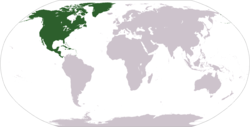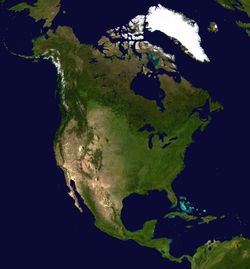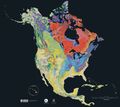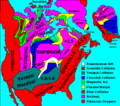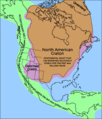North America
2007 Schools Wikipedia Selection. Related subjects: North American Geography
North America is a continent in the Earth's northern hemisphere and almost fully in the western hemisphere. It is bordered on the north by the Arctic Ocean, on the east by the North Atlantic Ocean, on the southeast by the Caribbean Sea, and on the south and west by the North Pacific Ocean; South America lies to the southeast, connected to North America by the isthmus of Panama. It covers an area of about 24,490,000 km² (9,450,000 sq mi), or about 4.8% of the planet's surface. As of October 2006, its population was estimated at over 514,600,000. It is the third-largest continent in area, after Asia and Africa, and is fourth in population after Asia, Africa, and Europe.
Etymology
North and South America are widely accepted as having been named after Amerigo Vespucci by the German cartographer Martin Waldseemüller. Vespucci was the first European to suggest that the Americas were not the East Indies, but a new world, previously undiscovered by Europeans.
The second and less generally accepted theory is that the continents are named after an English merchant named Richard Amerike from Bristol, who is believed to have financed John Cabot's voyage of discovery from England to Newfoundland in 1497. A minutely explored belief that has been advanced is that America was named for a Spanish sailor bearing the ancient Visigothic name of 'Amairick'. Another is that the name is rooted in an American Indian language.
Geography and extent
North America occupies the northern portion of the landmass generally referred to as the New World, the Western hemisphere, the Americas, or simply America. North America's only land connection is to South America at the narrow Isthmus of Panama. (Geopolitically, all of Panama—including the segment east of the Panama Canal in the isthmus—is often considered a part of North America alone.) According to some authorities, North America begins not at the Isthmus of Panama but at the Isthmus of Tehuantepec, Mexico with the intervening region called Central America (or Middle America if the Caribbean is included) and resting on the Caribbean Plate. Before the Central American isthmus was raised, the region had been underwater. The islands of the West Indies delineate a submerged former land bridge, which had connected North America and South America via Florida.
The continental coastline is long and irregular. The Gulf of Mexico is the largest body of water indenting the continent, followed by Hudson Bay. Others include the Gulf of Saint Lawrence and the Gulf of California.
There are numerous islands off the continent’s coasts: principally, the Arctic Archipelago, the Greater and Lesser Antilles, the Alexander Archipelago, and the Aleutian Islands. Greenland, a Danish self-governing island and the world's largest, is on the same tectonic plate (the North American Plate) but is not considered to be part of the continent. Bermuda is not part of the Americas, but is an oceanic island formed on the fissure of the Mid-Atlantic Ridge. The nearest landmass to it is Cape Hatteras, North Carolina, and it is often thought of as part of North America, especially given its historical political and cultural ties to Virginia and other parts of the continent.
Physical geography
The vast majority of North America is on the North American Plate. Parts of California and western Mexico form the partial edge of the Pacific Plate, with the two plates meeting along the San Andreas fault.
The continent can be divided into four great regions (each of which contains many sub-regions): the Great Plains stretching from the Gulf of Mexico to the Canadian Arctic; the geologically young, mountainous west, including the Rocky Mountains, the Great Basin, California and Alaska; the raised but relatively flat plateau of the Canadian Shield in the northeast; and the varied eastern region, which includes the Appalachian Mountains, the coastal plain along the Atlantic seaboard, and the Florida peninsula. Mexico, with its long plateaus and cordilleras, falls largely in the western region, although the eastern coastal plain does extend south along the Gulf.
The western mountains are split in the middle, into the main range of the Rockies and the coast ranges in California, Oregon, Washington, and British Columbia with the Great Basin – a lower area containing smaller ranges and low-lying deserts – in between. The highest peak is Denali in Alaska.
The United States Geographical Survey states that the geographic centre of North America is “6 miles west of Balta, Pierce County, North Dakota” at approximately 48° 10′North, 100° 10′West, approximately 15 miles (25 km) from Rugby, North Dakota. The USGS further states that “No marked or monumented point has been established by any government agency as the geographic centre of either the 50 States, the conterminous United States, or the North American continent.” Nonetheless, there is a 15 foot (4.5 m) field stone obelisk in Rugby claiming to mark the centre.
|
North American cratons and basement rocks. |
 Tectonic elements of North America |
North American craton. |
Human geography
The most spoken languages in North America are English, Spanish and French. The term Anglo-America is occasionally used to refer to Belize, the United States, the anglophone parts of the Caribbean and Canada, and Guyana (the only English-speaking nation of South America), and are included in the Anglosphere. The remaining Central American nations, Mexico, and the Spanish-speaking Caribbean and the other South American countries where Romance languages prevail (namely Spanish, Portuguese and French), are referred to as Latin America. This latter term has entered into common parlance, although the term "Anglo-America" remains largely unknown to most people.
The French language has historically played a significant role in North America and remains a distinctive presence in some regions. Canada has two official languages; French is the official language of the province of Quebec, and, along with English, one of the two official languages of the province of New Brunswick. Other French-speaking locales include: Dominica, Saint Lucia, the French West Indies and Saint-Pierre and Miquelon. Haiti is included with this group based on past historical association but Haitians speak Creole and not French. Although this language is derived from French, it is not French.
Socially and culturally, North America presents a well-defined entity. Canada and the United States have a shared culture and similar traditions as a result of both countries being former British colonies. A common cultural and economic market has developed between the two nations because of the strong economic and historical ties. Spanish-speaking North America shares a common past as former Spanish colonies. In Central American countries and Mexico where civilizations like the Maya developed, indigenous people preserve traditions across modern boundaries. Central American and Spanish-speaking Caribbean nations have historically had more in common due to geographical proximity and the fact that, after winning independence from Spain, Mexico never took part in an effort to build a Central American Union.
Economically, Canada and the United States are the wealthiest and most developed nations in the continent; the countries of Central America and the Caribbean are much less developed, while Mexico – a newly industrialized country – lies between these two extremes. The most important trade blocs are the Caribbean Community and Common Market (CARICOM), the North American Free Trade Agreement (NAFTA), and the recently signed Central American Free Trade Agreement (CAFTA) – the last of these being an example of the economic integration sought by the nations of this subregion as a way to improve their financial status.
Demographically, North America is a racially and ethnically diverse continent. Its three main ethnic groups are Whites, Mestizos and African-Americans. There is a significant minority of Amerindians and Chinese among other less numerous groups.
Countries and territories
North America is often divided into subregions but no universally accepted divisions exist. "Central America" comprises the southern portion of the continent, but its northern terminus varies between sources. The United Nations includes Mexico in Central America, while most other definitions of the region do not (e.g., the European Union excludes Belize and Mexico from the area). The term Middle America is sometimes used to refer to Mexico, Central America, and the Caribbean collectively.
Northern America is used to refer to the northern countries and territories of North America: Canada, the United States, Greenland, Bermuda, and St. Pierre and Miquelon.
The Caribbean is used to refer to the islands in the Gulf of Mexico and the Caribbean Sea.
| Name of region and territory, with flag |
Area (km²) |
Population (1 July 2005 est.) |
Population density (per km²) |
Capital |
|---|---|---|---|---|
| 102 | 13,254 | 129.9 | The Valley | |
| 443 | 68,722 | 155.1 | St. John's | |
| 193 | 71,566 | 370.8 | Oranjestad | |
| 13,940 | 301,790 | 21.6 | Nassau | |
| 431 | 279,254 | 647.9 | Bridgetown | |
| 22,966 | 279,457 | 12.2 | Belmopan | |
| 53 | 65,365 | 1,233.3 | Hamilton | |
| 153 | 22,643 | 148.0 | Road Town | |
| 9,984,670 | 32,805,041 | 3.3 | Ottawa | |
| 262 | 44,270 | 169.0 | George Town | |
| 51,100 | 4,016,173 | 78.6 | San José | |
| 110,860 | 11,346,670 | 102.4 | Havana | |
| 754 | 69,029 | 91.6 | Roseau | |
| 48,730 | 8,950,034 | 183.7 | Santo Domingo | |
| 21,040 | 6,704,932 | 318.7 | San Salvador | |
| 2,166,086 | 56,375 | 0.026 | Nuuk | |
| 344 | 89,502 | 260.2 | St. George's | |
| 1,780 | 448,713 | 252.1 | Basse-Terre | |
| 108,890 | 14,655,189 | 134.6 | Guatemala City | |
| 27,750 | 8,121,622 | 292.7 | Port-au-Prince | |
| 112,090 | 6,975,204 | 62.2 | Tegucigalpa | |
| 10,991 | 2,731,832 | 248.6 | Kingston | |
| 1,100 | 432,900 | 393.5 | Fort-de-France | |
| 1,972,550 | 106,202,903 | 53.8 | Mexico City | |
| 102 | 9,341 | 91.6 | Plymouth; Brades | |
| 5 | — | — | — | |
| 960 | 219,958 | 229.1 | Willemstad | |
| 129,494 | 5,465,100 | 42.2 | Managua | |
| 52,853 | 2,498,717 | 47.3 | Panama City | |
| 9,104 | 3,916,632 | 430.2 | San Juan | |
| 261 | 38,958 | 149.3 | Basseterre | |
| 616 | 166,312 | 270.0 | Castries | |
| 242 | 7,012 | 29.0 | Saint-Pierre | |
| 389 | 117,534 | 302.1 | Kingstown | |
| 5,128 | 1,088,644 | 212.3 | Port of Spain | |
| 430 | 20,556 | 47.8 | Cockburn Town | |
| 9,629,091 | 300,165,500 | 30.7 | Washington, D.C. | |
| 352 | 108,708 | 308.8 | Charlotte Amalie | |
| Total | 24,486,305 | 518,575,412 | 21.0 |
Notes:
- ^ a b c Depending on definitions, Aruba, Netherlands Antilles, Panama, and Trinidad and Tobago have territory in one or both of North and South America.
- ^ Physiographically, the southeastern portion of Mexico (east of the Isthmus of Tehuantepec) is considered a part of Central America. Geopolitically, Mexico is frequently not reckoned in Central America.
- ^ Due to ongoing activity of the Soufriere Hills volcano beginning 1995, much of Plymouth, Montserrat's de jure capital, was destroyed and government offices relocated to Brades.
- ^ Panama is generally considered a transcontinental country in Central America (UN region) and South America; population and area figures are for North American portion only, west of the Panama Canal.
- ^ Includes the US state of Hawaii, which is distant from the North American landmass in the Pacific Ocean and is, thus, commonly included with the other territories of Oceania.
Usage of the term
"North America" may mean different things to different people in the world according to the context:
- In Latin America, Iberia and some other parts of Europe, the Americas are often considered a single continent. Under such circumstances, North America is considered a subcontinent containing only Canada, U.S. and Mexico.
Sources:
- Fowler's Modern English Usage. ( ISBN 0198610211) New York: Oxford University Press, p. 48.
